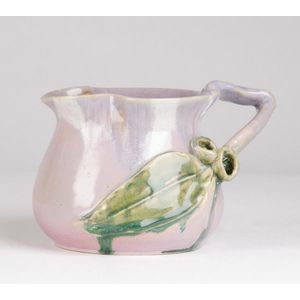Rene Lalique 'Yvelines' vase, 1926
You must be a subscriber, and be logged in to view price and dealer details.
Subscribe Now to view actual auction price for this item
When you subscribe, you have the option of setting the currency in which to display prices to $Au, $US, $NZ or Stg.
- Oviform /ovoid - The outline loosely resembling the shape of an egg.
- Pressed Glass - Pressed glass is a type of glassware that is produced by pressing molten glass into a mould. This manufacturing process involves using a mould to shape and form the glass while it is still in a semi-liquid or molten state. The glass is pressed into the mould to take on its design and texture.
The use of moulds allows for the mass production of glass items with consistent designs. Pressed glass became popular in the 19th century as a more economical alternative to hand-blown glass, as it allowed for faster and more efficient production. This method was widely used for creating various glass objects, including dishes, bowls, vases, and decorative items.
Pressed glass can have intricate patterns and designs, and it has been used for both utilitarian and decorative purposes. While it may not have the same artisanal quality as hand-blown glass, pressed glass has its own charm and has been a significant part of glassware history. - Patination / Patina - In broad terms, patination refers to the exterior surface appearance of the timber, the effect of fading caused by exposure to sunlight and air over the course of a century or more, changing the piece to a soft, mellow colour.
As patina is very difficult to replicate, it is one of the most important guides to determining the age of furniture.
Patina is also the term applied to the bloom or film found on old bronzes due to oxidisation. - Circa - A Latin term meaning 'about', often used in the antique trade to give an approximate date for the piece, usually considered to be five years on either side of the circa year. Thus, circa 1900 means the piece was made about 1900, probably between 1895 and 1905. The expression is sometimes abbreviated to c.1900.
This item has been included into following indexes:
-
Lalique (France), item types
- other items 1,054
- vases 536
Visually similar items

Baccarat crystal glass jug etched 'Baccarat France' to base, 16 cm high approx.

Daum Nancy, Vase, green glass, acid etched signature to side 'Daum Nacy France, height 13 cm

Three various art glass items. Engraved yellow glass vase; blue glass bowl; & Kosta Boda water jug. Height 22 cm (jug)

Remued: early pottery jug with applied gum leaf and nuts in green on pink/mauve glazed body with branch handle. Incised 'Remued Handmade, 185M'. Height 10 cm, width 17 cm.
